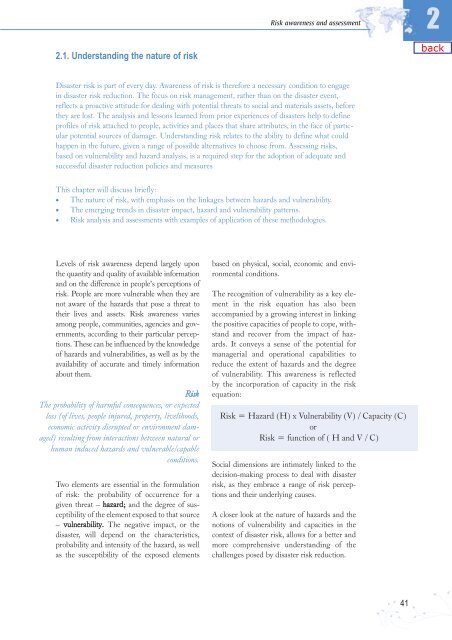Living with Risk. A global review of disaster reduction initiatives
Living with Risk. A global review of disaster reduction initiatives
Living with Risk. A global review of disaster reduction initiatives
Create successful ePaper yourself
Turn your PDF publications into a flip-book with our unique Google optimized e-Paper software.
<strong>Risk</strong> awareness and assessment<br />
2<br />
2.1. Understanding the nature <strong>of</strong> risk<br />
Disaster risk is part <strong>of</strong> every day. Awareness <strong>of</strong> risk is therefore a necessary condition to engage<br />
in <strong>disaster</strong> risk <strong>reduction</strong>. The focus on risk management, rather than on the <strong>disaster</strong> event,<br />
reflects a proactive attitude for dealing <strong>with</strong> potential threats to social and materials assets, before<br />
they are lost. The analysis and lessons learned from prior experiences <strong>of</strong> <strong>disaster</strong>s help to define<br />
pr<strong>of</strong>iles <strong>of</strong> risk attached to people, activities and places that share attributes, in the face <strong>of</strong> particular<br />
potential sources <strong>of</strong> damage. Understanding risk relates to the ability to define what could<br />
happen in the future, given a range <strong>of</strong> possible alternatives to choose from. Assessing risks,<br />
based on vulnerability and hazard analysis, is a required step for the adoption <strong>of</strong> adequate and<br />
successful <strong>disaster</strong> <strong>reduction</strong> policies and measures<br />
This chapter will discuss briefly:<br />
• The nature <strong>of</strong> risk, <strong>with</strong> emphasis on the linkages between hazards and vulnerability.<br />
• The emerging trends in <strong>disaster</strong> impact, hazard and vulnerability patterns.<br />
• <strong>Risk</strong> analysis and assessments <strong>with</strong> examples <strong>of</strong> application <strong>of</strong> these methodologies.<br />
Levels <strong>of</strong> risk awareness depend largely upon<br />
the quantity and quality <strong>of</strong> available information<br />
and on the difference in people’s perceptions <strong>of</strong><br />
risk. People are more vulnerable when they are<br />
not aware <strong>of</strong> the hazards that pose a threat to<br />
their lives and assets. <strong>Risk</strong> awareness varies<br />
among people, communities, agencies and governments,<br />
according to their particular perceptions.<br />
These can be influenced by the knowledge<br />
<strong>of</strong> hazards and vulnerabilities, as well as by the<br />
availability <strong>of</strong> accurate and timely information<br />
about them.<br />
<strong>Risk</strong><br />
The probability <strong>of</strong> harmful consequences, or expected<br />
loss (<strong>of</strong> lives, people injured, property, livelihoods,<br />
economic activity disrupted or environment damaged)<br />
resulting from interactions between natural or<br />
human induced hazards and vulnerable/capable<br />
conditions.<br />
Two elements are essential in the formulation<br />
<strong>of</strong> risk: the probability <strong>of</strong> occurrence for a<br />
given threat – hazard; and the degree <strong>of</strong> susceptibility<br />
<strong>of</strong> the element exposed to that source<br />
– vulnerability. The negative impact, or the<br />
<strong>disaster</strong>, will depend on the characteristics,<br />
probability and intensity <strong>of</strong> the hazard, as well<br />
as the susceptibility <strong>of</strong> the exposed elements<br />
based on physical, social, economic and environmental<br />
conditions.<br />
The recognition <strong>of</strong> vulnerability as a key element<br />
in the risk equation has also been<br />
accompanied by a growing interest in linking<br />
the positive capacities <strong>of</strong> people to cope, <strong>with</strong>stand<br />
and recover from the impact <strong>of</strong> hazards.<br />
It conveys a sense <strong>of</strong> the potential for<br />
managerial and operational capabilities to<br />
reduce the extent <strong>of</strong> hazards and the degree<br />
<strong>of</strong> vulnerability. This awareness is reflected<br />
by the incorporation <strong>of</strong> capacity in the risk<br />
equation:<br />
<strong>Risk</strong> = Hazard (H) x Vulnerability (V) / Capacity (C)<br />
or<br />
<strong>Risk</strong> = function <strong>of</strong> ( H and V / C)<br />
Social dimensions are intimately linked to the<br />
decision-making process to deal <strong>with</strong> <strong>disaster</strong><br />
risk, as they embrace a range <strong>of</strong> risk perceptions<br />
and their underlying causes.<br />
A closer look at the nature <strong>of</strong> hazards and the<br />
notions <strong>of</strong> vulnerability and capacities in the<br />
context <strong>of</strong> <strong>disaster</strong> risk, allows for a better and<br />
more comprehensive understanding <strong>of</strong> the<br />
challenges posed by <strong>disaster</strong> risk <strong>reduction</strong>.<br />
41

















